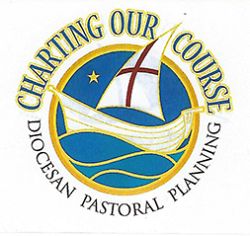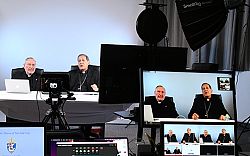Pastoral Plan update under way
SALT LAKE CITY — For the better part of a decade, the Diocese of Salt Lake City has been involved in the process of a Pastoral Plan. Work began under the Most Rev. John C. Wester, ninth bishop of the diocese, but was halted in 2015 when he was named Archbishop of Santa Fe. Preparations began again in 2017 after the Most Rev. Oscar A. Solis was installed as the diocese’s 10th bishop, and the Pastoral Plan was published in 2018.
The plan has five objectives: faith formation, vocations, stewardship, Eucharist and Catholic identity, and the dignity of the human person. When the plan was published, each parish or mission was asked to review these objectives and implement them in ways that best fit their individual community.
Originally, the Pastoral Plan covered five year, from 2018 to 2023. However, the Covid pandemic interrupted its implementation, and Pope Francis’ Synod on Synodality also opened new questions about the objectives. Therefore, last year Bishop Solis convened parish and diocesan leaders to review the plan in light of the results from the diocesan synod meetings. In addition, each parish was asked to formulate its own pastoral plan for the next three years.
On May 1, Bishop Solis again met with parish and diocesan leaders via Zoom; many parishes had their leadership groups attend the session, then held a discussion afterward.
The purpose of the May 1 diocesan Spring General Assembly was to discuss the mission of evangelization in the local Church in Utah, Bishop Solis said. He asked those present to “continue to work together in building a missionary Church with spirit-filled evangelizers and lead the people of God in our faith journey as a Church in Utah.”
A report from the deaneries by Fr. David Bittmenn, pastor of St. George Parish in St. George, highlighted the need for parishes to take individual approaches to their implementation of the Pastoral Plan. As Fr. Bittmenn pointed out, not all areas of the diocese share the same problems. For example, in the northern part of the state, many parishes have high demand for religious education programs, though religious education teachers are few, he said. However, other parishes along the Wasatch Front are facing a population decline, while in still other places the population continues to grow and there is a need to build more churches.
On the other hand, in rural areas, which are home to most of the missions and stations in the state, “Resources aren’t plentiful in many areas, but they are better than what they used to be,” Fr. Bittmenn said. “The diocese has always held a special place in its heart for her missions.”
While parishes will make their own choices regarding specific implementation of the plan, a common overall approach is being taken. In December, parishes were asked for input on how to update the Pastoral Plan. The results of their reports were discussed at the May 1 meeting.
Most of the parishes agreed that the same priorities should be kept, but almost a third suggested reorganizing them. More than half of the parishes responding said that faith formation should be the focus for 2023.
Several observations were made in response to a question about whether there were strategies that should be implemented going forward under the priorities of the Pastoral Plan. These observations included a need to address the issues of “the lack of vocations, money and Catholics in Utah to provide long-term solutions that deal with the reality.”
Two other observations were that “Many families are in crisis. We need good marriage preparation and a serious pastoral accompaniment of marriages,” and “We talk about the mission of our Church, but there is no specific point [in the Pastoral Plan] that speaks explicitly about the mission.”
Among the feedback from the parishes regarding the update were that the goal of stewardship should address time and talent as well as the financial aspect; and that faith formation of youth and families should be emphasized along with adult faith formation, said Fr. Wayne Cavalier, a consultant from the Congar Institute for Ministry Development who has helped with the Pastoral Plan since the beginning. In addition, there was the suggestion that the goal of vocations highlight the call to marriage as well as to priesthood and religious life; and a request for more lay leadership formation training, he said.
At the May 1 meeting, the parish groups were asked to consider whether the Pastoral Plan priorities should be expanded to include welcoming, youth and young adult ministry, and evangelization. The reports from the parish groups were due at the diocese on May 8.
“The point of all this is to keep progressing toward our goal to be a missionary Church in an intentional and collaborative manner, and to help one another be accountable in making progress in the direction that we have identified,” Fr. Cavalier said.
© Copyright 2025 The Diocese of Salt Lake City. All rights reserved.



Stay Connected With Us